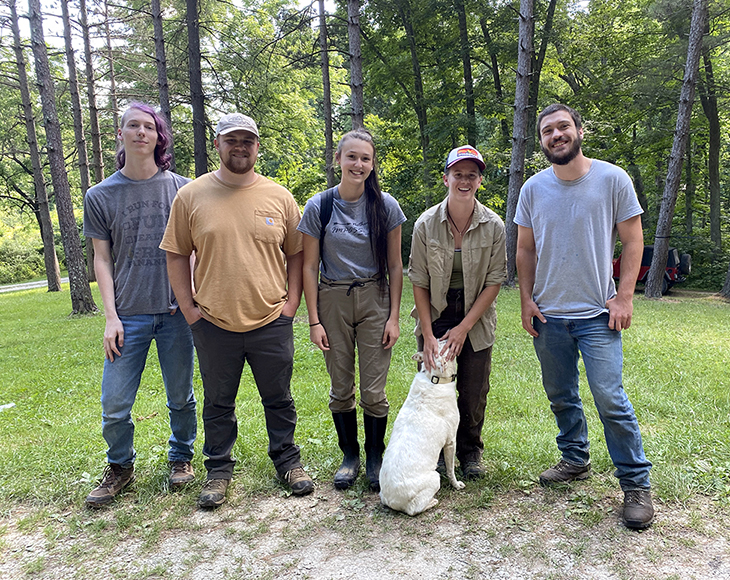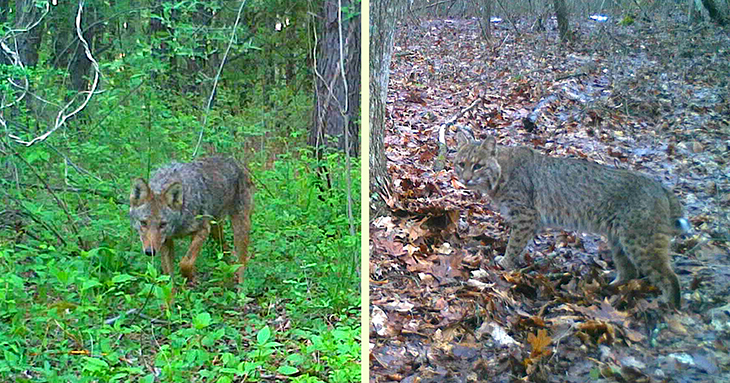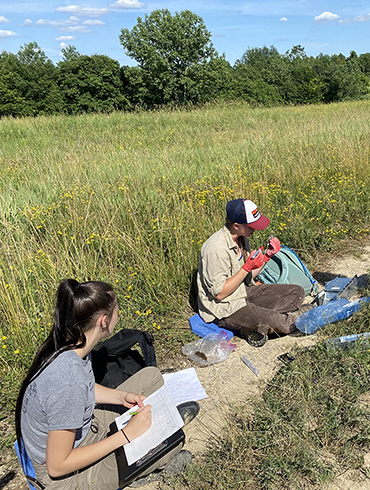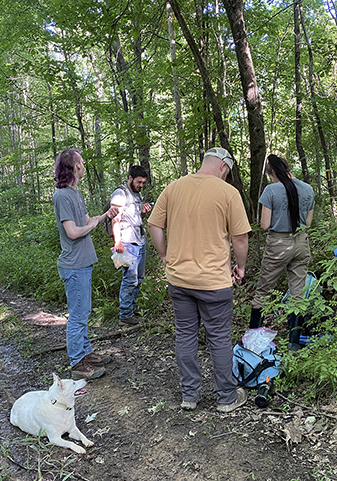
July 5, 2021
Immersed in the forested wilderness of southeast Ohio, biology PhD student at Ohio University Marissa Dyck is spending her summer gathering clues about Ohio’s bobcat and coyote populations.
Both medium-sized carnivores, bobcats and coyotes eat much of the same prey, such as rodents, squirrels and rabbits, and prefer similar habitats including forests and grasslands, said Dyck, a member of Ohio University professor Viorel Popescu’s conservation biology lab. Although both animals have been expanding their range in the state, she said it’s unclear how much competition exists between the two species.
To determine how bobcats and coyotes might be sharing resources, Dyck and her research team have around 60 cameras hidden across four locations in southeast Ohio, where most of Ohio’s bobcats reside. They’re also estimating prey availability surrounding their campground at AEP ReCreation Land in Morgan County. The OWMA recently caught up with Dyck and her team of undergraduate researchers to ask more about their work.

Can you explain the aims of your work this summer?
MD: Right now, we’re doing small mammal trapping to estimate prey availability for bobcats and coyotes, which will compliment a broader study funded by the Ohio Department of Natural Resources to assess the status of Ohio’s recovering bobcat population. Bobcats were locally extinct in Ohio for about a century due to unregulated harvesting and habitat loss, and they’ve just begun to recover in the last 50 years or so. Meanwhile, coyotes have also expanded their range eastward into Ohio, so there’s a new dynamic with these two species that haven’t occurred here together historically but do co-occur elsewhere in North America.

We’re interested in how they’re partitioning resources — diet, habitat, space, time — and we’ll be pairing the data from our camera traps with the prey availability data we gather here to see how differences in prey abundance or species diversity might affect co-occurrence. To get an idea of what small mammals are in the area, we’re attracting them to traps near our camera sites using two types of bait: a peanut butter oat mixture and bird seed. Animals we capture are examined to determine species, sex, age and general condition and are marked with a unique ear tag before being released.
What has driven bobcat and coyote expansion?
MD: The loss of larger apex predators in Ohio like wolves and mountain lions left available niches and resources for these meso-carnivores like coyotes, bobcats and foxes. For bobcats specifically, forest regeneration and the fact there is no harvest led to expansion, because harvesting and habitat loss were the main reasons bobcats went extinct in the first place. A large part of the ODNR-funded project is focused on estimating bobcat density in southeast Ohio, what their population could look like in the future and how different management scenarios might affect the population. One aspect of this research included collecting scats and identifying individual bobcats based on their genetic makeup.
What challenges face the long-term survival of bobcats or coyotes?
MD: Both species seem to be expanding their range and doing fairly well — they overlap in most of our study areas and there doesn’t appear to be any severe competitive exclusion, although we can’t say for sure without doing analyses. Of course, they’ll also have to deal with the broad challenges all species are facing regarding climate change and increased human footprint. We don’t know what effects that will have on these mammals.

What are your next steps?
MD: I plan to analyze the small mammal and camera trap data and write a manuscript this winter, which I’ll include in my dissertation. Personally, after I graduate, I’ll be searching for post-doc opportunities to continue doing conservation-related research and mentoring younger scientists.
What has this research experience provided for your undergraduate team?
MD: It’s a big booster on your CV to have field work experience, which was particularly hard to find amid COVID-19, so hopefully they’re getting good experience learning what goes into doing field work like this — which is that things don’t go as planned pretty much ever. So hopefully they’re learning how to think on their feet and be resourceful in challenging situations.
Is there anything Ohioans should know?
MD: I know there are worries that bobcats could attack livestock or pets. It’s important for people to know that bobcats are shy and not typically comfortable around humans, and they do not pose a threat to animals, livestock or people. Coyotes are a very adaptable species and will sometimes take advantage of unattended small livestock or pets. However, both species play roles in Ohio’s ecosystems and likely provide important services to people by keeping small mammal populations in check.
Otherwise, I hope people just enjoy that bobcats are back here in Ohio. Ohio University is home of the Ohio Bobcats, so it’s nice that our mascot is currently in the state.